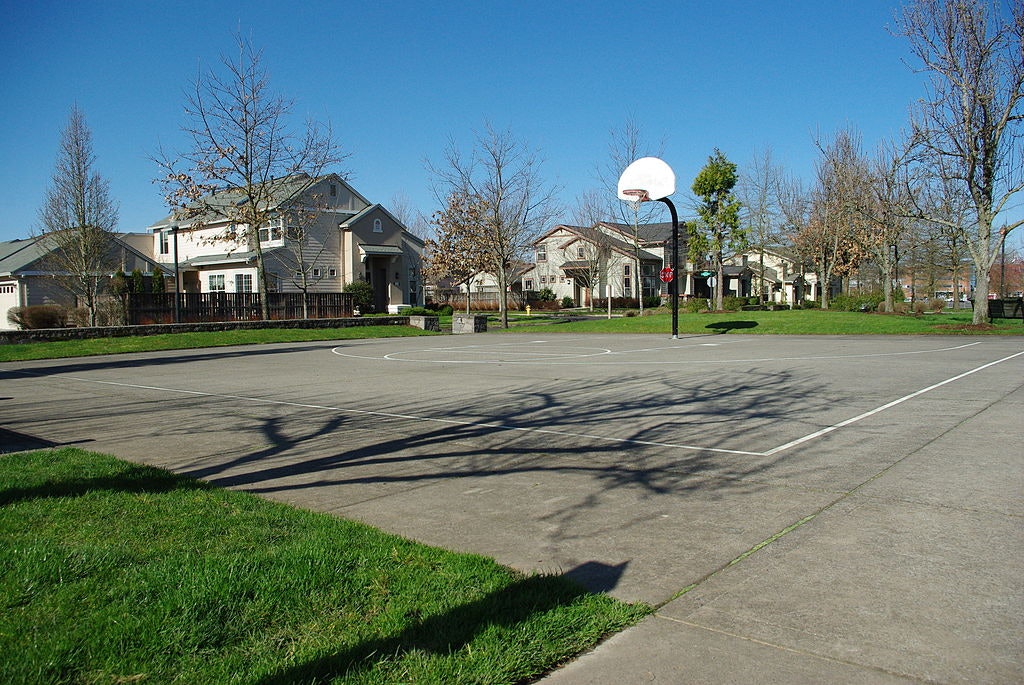
Photo of basketball court in Hillsboro, Oregon is by M.O. Stevens, available via Wikimedia Commons
Bruce Lear lives in Sioux City and has been connected to Iowa’s public schools for 38 years. He taught for eleven years and represented educators as an Iowa State Education Association regional director for 27 years until retiring. He can be reached at BruceLear2419@gmail.com
No Apple phones, No Madden 24 NFL, and there was not a Tik or a Tok to be found. It was just a fenced concrete slab and two slightly bent backboards with chain nets. There wasn’t free throw line or half court markings. It was strictly BYOB, bring your own basketball.
The ball sometimes flew over the fence and landed in Bear Crick. We took turns wading in or finding a big enough stick to retrieve the errant ball. Sometimes the lights blazed long after we’d been called to supper, but since we lived a block away, I’d be sent down to switch them off.
When it snowed, we shoveled, hoping we’d scraped enough so our Converse shoes would grip the remaining ice. There were no referees, no coaches, and no scoreboard. If you cried or had a temper tantrum, you were not so politely directed to go home.
Fouls were self-called and often adjudicated when in dispute. No free throws, just a change of possession. We learned the rules of the game, how to compromise, and some words never dared uttered in Sunday school.
It was intergenerational basketball and often not gender specific. Junior high kids mixed with high school varsity and junior varsity players. Girls were welcome. Some, like my sister, were chosen before the boys. She could play.
The varsity players were our heroes. It was one thing seeing them play on Tuesday and Friday from the bleachers. It was quite another to be playing with them and against them on our court.
On the basketball court, it was rough democracy.
But it worked, and we governed it.
We were friends, even if we had nothing but basketball in common. We could fight for the ball, and maybe even get into a fight over the game, but at the end we walked away knowing we wanted to do it again the next day.
We learned if we had too many fights about fouls and rules, we’d never get to finish the game. If that happened, players would get fed up and walk away. Nobody won.
That reminds me of what’s happening now in American politics. Often, legislators seem more interested in fighting about rules and fouls to gain team advantage than they are about winning for those they represent.
On the court, sometimes, we’d have to forget about the foul, even if it was flagrant, so we could continue to play. It seemed like we all had an instinct for a fight worth ending the game. It was rare.
Both parties seem to lack that instinct of when to fight and when to compromise. They refuse to understand there won’t be winners if there isn’t a game.
We all lose.
Many politicians are willing to sacrifice results so they can mug for cameras, celebrating anger instead of searching for solutions. The worst fights on the court were fueled by onlookers cheering. The worst political fights happen now when voters reward combatants.
Plenty of issues can’t be resolved unless both sides participate. Without some compromise, there will be a partial federal government shutdown in January, Ukraine and Israel won’t get the aid they need, the U.S. border won’t be strengthened, and all Americans will walk away in disgust from a game suspended by fighting.
I didn’t learn everything I needed to know on the basketball court. But I learned when to fight and when to play ball. Abraham Lincoln was accurate when he quoted from Mathew 12: “A house divided cannot stand.” Refusing to compromise will lead to chaos. No one wins.

1 Comment
what are you talking about?
“Both parties seem to lack that instinct of when to fight and when to compromise. They refuse to understand there won’t be winners if there isn’t a game.”
when you look at the record of this year’s congressional activities what do you point to as evidence of this bothsidesism?
dirkiniowacity Fri 29 Dec 2:05 PM